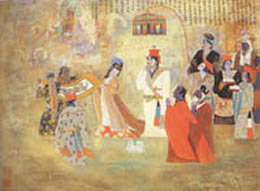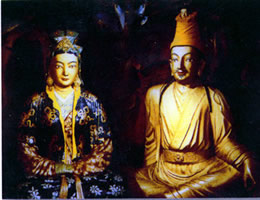About 1,300
years ago, Princess Wencheng of the Tang Dynasty (618-907) left the capital
Chang'an (present-day Xi'an in Shanxi Province) for the Tubo Kingdom,
today's Tibet, which was about 2,000 miles away in the southwest. She
was to join Songtsan Gambo, King of Tubo, to whom her royal father had
just married. This interracial matrimony helped strengthen the ties between
the Tang Dynasty and the Tubo Kingdom. The story of Princess Wencheng
and Songtsan Gambo has been cherished by the Tibetans and the rest of
the Chinese people ever since. As historical record is sketchy, most what
is known about the story is legendary.
 |
| Songtsan Gambo
welcomes Princess Wencheng |
Historically,
China’s central plains, which had split for many years, were reunited
by the Tang Dynasty in the 7th century. Under the reign of Li Yuan (Emperor
Gaozong) and Li Shimin (son of Li Yuan and Emperor Taizong), Tang became
a powerful and prosperous nation and its capital Chang’an a political,
economical and cultural center. The influence of Tang was felt throughout
East and Central Asia. Commercial and cultural exchanges between Tang
and its neighbors were active.
In 629,
the third year of Emperor Li Shimin's reign, a coup d'etat took place
in Tubo. Its 31st Zanpu, or King, was assassinated by his political
opponent. The kingdom was seized with a movement of separatism championed
by the aristocrats bent on returning to the old system. Songtsan Gambo
became the 32nd Zanpu. Though he was only thirteen at the time,
he was already a resourceful statesman. Calmly exploiting his diplomatic
and military clout, he crushed the separatist movement, and in three years
Tubo became an integrated kingdom again. Then he crossed the Yalutsangbo
River and established the capital at today’s Lhasa. Songtsan Gambo
has since become a national hero of the Tibetans and worshiped like the
revered Lamas.
After the
reunification, Songtsan Gambo concentrated on building Tubo into a powerful
kingdom. One of his nation-building strategies was to inject new cultures
into Tubo. To do so, he found it the most convenient way to establish
matrimonial relationships between his royal family and those of his neighboring
countries. After marrying a princess from Nepal, he turned his attention
to Tang. A hero himself, he admired Emperor Taizong of Tang for his
great talent and bold vision. He thought he, as well as his kingdom, could
gain a lot by his marriage with a daughter of the Tang emperor. Incidentally,
both the princesses later brought, among other things, the religion of
Buddhism, thus converting him into a Buddhist. The Tang emperor, on the
other hand, was only too happy to have Tubo as a tributary of Tang by
a royal matrimony between his daughter Princess Wencheng and Songtsan
Gambo.
In the
process of its propagation, the legend of Princess Wencheng and her matrimonial
journey to what is today's Tibet has evolved into several versions, with
increasing numbers of episodes added each time. It is therefore difficult
to separate fiction from historical reality. Historic relics, however,
are not hard to find on the trail of the wedding trip. Statues of the
royal couple are still worshiped in the Potala Palace at Lhasa today.
It was a
wintry day. Lu Tongtsan and his hundred-strong entourage arrived in Chang'an
with 5,000 taels of gold and several hundred items of treasure. Emperor
Taizong of Tang received them in his richly ornamented palace. There,
Lu Tongtsan presented Songtsan Gambo’s letter of proposal along
with the gifts. Though impressed with Lu Tongtsan’s elegant manner,
Emperor Taizong refrained from acceding to Songtsan Bambo's proposal right
away. He put Lu Tongtsan and his men up in the royal hotel together with
a dozen envoys and their subbordinates from other countries who had come
for the same purposes. The emperor needed to find a tactical way to decline
them so that he could marry the princess off to Lu Tongtsan's monarch
Songtsan Gambo. Having a contest among them seemed to be a good idea.
To make the contest look like a fair game, he demanded that five rounds
be held, each being a practical puzzle. He proclaimed that he would marry
his daughter Princess Wencheng to any monarch whose envoy could first
solve the five puzzles.
....
 |
| The
statues of Princess Wencheng and Songtsan Gambo in the Jokhang Monastery |
Songtsan Bambo had
the Ramoche Monastery built for the Buddha statues that Princess Wencheng
had brought with her. The princess herself also had the Jokhang Monastery
built, and in front of it she and Songtsan Gambo planted some willow trees
now known as tangliu (the Tang willow). Today, the original statue of
Sakyamuni believed to be brought by Princess Wencheng is still enshrined
in the center of the main hall of the Jokhang Monastery.
Songtsan Gambo died in 650, a year after the death of Emperor Taizong of Tang.
Songtsan Gambo was only thirty-four years old. Prince Wencheng passed
away thirty years later. A ceremonious funeral was held for the beloved
princess. Generation after generation of poets have written numerous verses
to eulogize her. Her story was adapted to various theatrical forms. Two
traditional observations have been devoted to her: the fifteenth day of
the fourth month of each Tibetan year (the day when Princess Wencheng
arrived in Tubo) and the fifteenth day of the tenth month of each Tibetan
year (the birthday of Princess Wencheng). When the days come each year,
the Tibetan people will turn out in their best costumes to sing and dance
to commemorate her. Her statue and that of Songtsan Gambo are worshiped
in the Jokhang Monastery. The chamber where they spent their first married
life is still kept intact in the Potala Palace.
Story
retold/ translated by Haiwang Yuan, ©2004
Last updated: September 10, 2008 |